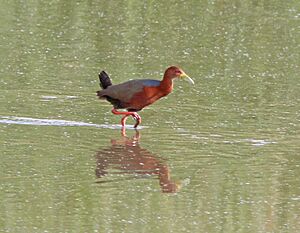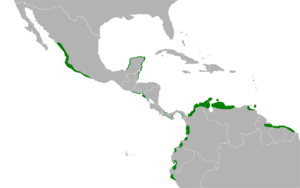Rufous-necked wood rail facts for kids
Quick facts for kids Rufous-necked wood rail |
|
|---|---|
 |
|
| Conservation status | |
| Scientific classification | |
| Genus: |
Aramides
|
| Species: |
axillaris
|
 |
|
The rufous-necked wood rail (Aramides axillaris) is a type of bird that belongs to the rail family. It lives in Mexico, Central America, several countries in South America, and on the island of Trinidad.
Contents
What Does It Look Like?
The rufous-necked wood rail is about 29 to 33 centimeters (11 to 13 inches) long. It weighs around 300 to 325 grams (10 to 11 ounces). Both male and female birds look the same.
They have long, strong, yellow-green beaks. Their legs and feet are red. Adult birds have a reddish-brown head, neck, and chest. The back of their neck and upper back are gray. The rest of their back is olive-brown or greenish-olive. Their wings are greenish-olive and chestnut brown. Their bottom, tail, sides, and the feathers under their tail are black. Their throat is white, and their belly is grayish-brown.
Younger birds (juveniles) are not as brightly colored. Their upper parts look similar to adults but are duller. Their face, chin, and upper neck are a light brown or dirty white with a hint of cinnamon. The lower parts of their sides and the feathers under their tail are a deep brownish-olive. The rest of their underside is a light brown with a touch of cinnamon.
Where Does It Live?
The rufous-necked wood rail is found along the coasts of Mexico, both on the Pacific side and the Yucatán Peninsula. It also lives along the Pacific and Caribbean coasts of Central America, though not everywhere.
In South America, you can find it along the Pacific coast. This includes parts of Colombia, Ecuador, and northern Peru. It also lives along the Caribbean coast from Colombia through Venezuela and the Guianas, and on the island of Trinidad. Once, a bird even flew far off course and was seen in New Mexico in the United States! Many bird watchers traveled there to see it.
For a long time, people thought these birds only lived near the coast, especially in mangrove forests. But now, more and more sightings are happening inland. They have been seen in different types of forests, even high up in mountains (as high as 1,400 meters or 4,600 feet). This suggests that they might move between coastal areas and mountains depending on the season. Mangroves might be their winter home.
How Does It Behave?
Movement and Migration
People used to think these birds stayed in the same place all year. However, there is now strong evidence that they move between different elevations (heights) depending on the season. This is especially true in Central America and possibly in western South America. They might move up into the mountains during certain times of the year and then back down to the coast.
What Does It Eat?
The rufous-necked wood rail usually looks for food in the early morning and late evening. Even though it's a shy bird, it sometimes comes out into the open. You might see it on muddy areas or riverbanks. Its main food is crabs, but it also eats other small creatures that live in the water.
Reproduction and Life Cycle
We don't know a lot about how the rufous-necked wood rail raises its young. The time of year when they breed seems to be different in various places. There aren't many records of their nests. Some nests have been found in inland forests. One person described two nests as open bowls made of twigs. They were lined with plant stems and both dead and green leaves. These nests were placed in a small tree and on a tree stump. Both nests had five eggs.
What Sounds Does It Make?
The song of the rufous-necked wood rail is described as loud, uneven kip and kow sounds. For example, it might sound like kip-kow-kip, kow-kip-kow, kip-kowkip-kow, kow, kow, kow-kip. Pairs of birds also sing together in a duet. Their duet is a strong series of musical notes like CHI burr... CHI burr... CHI burr..... They mostly sing at dusk and dawn, but sometimes at night too. When they are alarmed, they make a clucking sound and a kik sound.
Is It Safe?
The IUCN (International Union for Conservation of Nature) says the rufous-necked wood rail is a species of "Least Concern." This means it is not currently considered endangered. It lives across a very large area, and there are at least 50,000 adult birds. However, this number is thought to be going down. No immediate big threats have been found for the species as a whole.
But in some countries, like Mexico and Costa Rica, they are considered endangered. The mangrove forests where they live are in danger from new buildings, pollution, and changes in sea level. All these problems are caused by humans.


